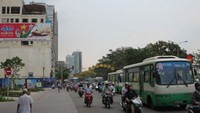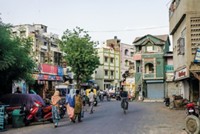Advertisement
Grab your lab coat. Let's get started
Welcome!
Welcome!
Create an account below to get 6 C&EN articles per month, receive newsletters and more - all free.
It seems this is your first time logging in online. Please enter the following information to continue.
As an ACS member you automatically get access to this site. All we need is few more details to create your reading experience.
Not you? Sign in with a different account.
Not you? Sign in with a different account.
ERROR 1
ERROR 1
ERROR 2
ERROR 2
ERROR 2
ERROR 2
ERROR 2
Password and Confirm password must match.
If you have an ACS member number, please enter it here so we can link this account to your membership. (optional)
ERROR 2
ACS values your privacy. By submitting your information, you are gaining access to C&EN and subscribing to our weekly newsletter. We use the information you provide to make your reading experience better, and we will never sell your data to third party members.
Business
Making Aromatics In Singapore
Global consortium is building one of the world’s largest p-xylene plants in the city-state
September 19, 2011
| A version of this story appeared in
Volume 89, Issue 38

An unlikely collection of international companies has started to build one of the world’s largest p-xylene plants in Singapore, a place where there is little demand for the material. The list of promoters backing the project, Jurong Aromatics, includes a Chinese polyester producer, a South Korean oil refiner, a Swiss commodities trader, and the Singaporean government.
Jurong Aromatics At A Glance
Location: Jurong Island, Singapore
Shareholders: SK Energy (30.0%), Jiangsu Sanfangxiang (25.0%), Glencore (10.0%), Vinmar (10.5%), Sridjaja family (9.5%), Singapore government (5.0%), Thai KK (5.1%), Essar (4.9%)
Investment amount: $2.4 billion
Start of production: 2014
Main products (annual capacity in metric tons): p-Xylene (800,000), benzene (440,000), o-xylene (200,000), and various fuels (2.5 million)
Construction of the $2.4 billion project got under way last month, roughly two years behind schedule because of financing difficulties. It is led by a U.S. citizen who was born in Iran, educated in England, and resides in Canada. But Mehdi Adib, Jurong Aromatics’ chief executive officer, describes his patchwork venture as an extraordinarily solid one.
“Our entire production is sold for the next seven years, with the buyers having the option to renew for seven years after that,” he says. More important, he points out, the companies that have invested in Jurong Aromatics are essentially the same ones that are buying its output and supplying it with raw materials. “There is very little risk,” Adib maintains.
The international banks that are providing $1.6 billion in loans to Jurong Aromatics apparently concur. They are a motley crew that includes the Dutch bank ING, Royal Bank of Scotland, Australia & New Zealand Banking Group, and Korea Development Bank. The banks have agreed to provide loans to Jurong Aromatics on a nonrecourse basis, which means that should the venture go bankrupt, the banks cannot get their money back from the project’s owners. The banks delayed funding the project for two years not because they ever doubted its viability, Adib says, but because of the global financial crisis that hit in 2008.
The presence of Adib at the helm of Jurong Aromatics almost certainly helps to soothe any worries the bankers may have about their money. With 40 years of experience behind him, Adib has been everywhere and done it all in the international refining and petrochemical industries. For roughly half of his career, he managed the construction of refineries and chemical plants for leading contractors such as Bechtel and Lummus. During the other half, he worked for companies that operate such facilities. He has worked in the Middle East, South America, and Canada, where he now resides in the western province of British Columbia.
Having previously managed development of the $22 billion ChemaWEyaat chemical complex in Abu Dhabi, Adib almost seems like an oversized manager for Jurong Aromatics, which is straightforward in comparison. But Adib sees challenges in operating the Singapore venture, which will be based on a standard process licensed from Honeywell subsidiary UOP. “We must meet all our obligations toward our lenders, complete the project on time and on budget, and produce an operational profit,” he says.
Jurong Aromatics is using Singapore strictly as a manufacturing base and not as a source of feedstock or a significant market. The venture’s main product, p-xylene, will be shipped off to feed plants in China and elsewhere that produce the polyester raw material purified terephthalic acid (PTA). In addition to p-xylene, Jurong Aromatics will make benzene, o-xylene, and various fuels. Adib expects that some of the jet fuel his venture produces will be consumed in the city-state. Singapore Changi Airport is one of Asia’s busiest.
One of the main buyers for Jurong Aromatics’ p-xylene will be Jiangsu Sanfangxiang, a major Chinese polyester producer that owns 25% of the Singapore project. Sanfangxiang purchases about 2 million metric tons of p-xylene annually, according to Adib. “Our plant will only provide a small portion of that amount,” he says.
The South Korean refiner SK Energy, which has a 30% stake in Jurong Aromatics, will both supply the venture with feedstock and buy from it. The oil company BP, which happens to be the world’s largest PTA producer, will also be both a supplier and customer, but it will not own a stake in Jurong.
Jurong Aromatics’ main feedstock will be natural gas condensate that it imports into Singapore. The Singaporean government is now completing construction of gigantic rock caverns about 400 feet underground for the safe storage of flammable feedstocks such as condensate and naphtha. The rock caverns will add to the already impressive infrastructure that the oil and chemical industries enjoy in Singapore.
Even though it’s neither a source of raw materials nor a major market, Singapore is a great location for Jurong Aromatics, Adib says. The government’s support of the chemical and refining industries has turned Singapore into one of Asia’s main hubs for the supply, distribution, and manufacturing of petroleum and petrochemical products, he says. The large oil and chemical industry in the city-state will be the source of the manpower and support services that an aromatics producer needs. “Costs in Singapore are not the lowest, but when you add together all the elements, Singapore stands way above other countries,” Adib says.
In contrast to the stability that Singapore provides, the aromatics business has been a volatile one in the past few years. The price of p-xylene has fluctuated between $600 and $1,600 per metric ton since 2008, says Tiankanok Sirichayaporn, a Bangkok-based senior aromatics analyst at Nexant, which advised the project. The price of benzene oscillated between $300 and $1,100 per metric ton during the same period.
Fluctuations in the price of crude oil are largely responsible for the wild swings in aromatics pricing, Sirichayaporn says. But other factors have also been at play. This year, for example, several plants unexpectedly stopped producing, leading to tightness in supply. One of the firms to endure plant outages is Formosa Plastics, which idled a major petrochemical facility in Taiwan after a series of fires. The tightness in supply of p-xylene comes at a time of strong demand for polyester fibers, which often substitute for natural ones. “Cotton is considerably more expensive than the average of the past 20 years,” Sirichayaporn notes.
It’s impossible to know what the aromatics market will be like in 2014 when Jurong Aromatics comes on-line. But Adib says long-term prospects in Asia are bright. “Demand is constantly up because aromatics ultimately end up in consumer products, and standards of living are going up in Asia,” he says. In any case, with sales contracts covering Jurong Aromatics’ first seven years of operation, the strength of future market demand is a long way down the list of Adib’s concerns. ◾






Join the conversation
Contact the reporter
Submit a Letter to the Editor for publication
Engage with us on Twitter